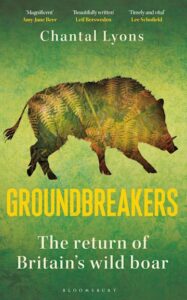 When the subject of large, and potentially dangerous, animals that have been extirpated from the U.K. over the past few millenia arises, the usual suspects that come to mind are wolves, bears, lynx, and Aurochs. Any one of these in their previous wild state would have struck fear into the hearts of Britons who were contemporary with them, and such being the case, the people of the islands would have taken great care not to inadvertently bump into one lest substantial risk to life and limb be realized. Unfortunately, as each disappeared and allowed the remaining humans likely to breath a sigh of relief, the natural balance of the region was deprived of a significant participant, resulting in disruption of the biomes from which they had been removed.
When the subject of large, and potentially dangerous, animals that have been extirpated from the U.K. over the past few millenia arises, the usual suspects that come to mind are wolves, bears, lynx, and Aurochs. Any one of these in their previous wild state would have struck fear into the hearts of Britons who were contemporary with them, and such being the case, the people of the islands would have taken great care not to inadvertently bump into one lest substantial risk to life and limb be realized. Unfortunately, as each disappeared and allowed the remaining humans likely to breath a sigh of relief, the natural balance of the region was deprived of a significant participant, resulting in disruption of the biomes from which they had been removed.
But what about the Wild Boar (Sus scrofa)? While not exactly always thought of as a dangerous predator, a full-grown boar possesses the physical size, capacity, and tenacity to inflict significant damage up to and including loss of limb and life if met in the wild. Consequently, those who lived in the British Isles before these creatures became extinct there (sometime in pre-history in Ireland, around the late medieval period in Great Britain) undoubtedly took care not to happen upon one unawares. And, as with the disappearance of the other large mammals of the islands, a substantial disruption of the biomes in which they lived occurred upon their removal.
Just how much of a disruption the extirpation of Wild Boar from Great Britain caused, and how the modern day human inhabitants of the area are accommodating themselves to the recent re-introduction of these long-absent artiodactyls to it, are explored at length by Chantal Lyons in her recently published book Groundbreakers; The Return of Britain’s Wild Boar. Originally begun as a revisiting of her dissertation topic, in Groundbreakers Ms. Lyons builds upon her return to the Forest of Dean, as well as other areas, to seek both the Wild Boar and the human residents now co-existent once again after seven centuries. She also digs deep into the effects – many quite surprising – that the now-returned Wild Boar are having upon the land, and the flora and other fauna that call it home; effects most often not easily classifiable into the simple categories of “good” and “bad,” and certainly not ones seen in the areas of reintroduction for many hundreds of years.
A lively book indeed, Groundbreakers is both eye-opening and highly informative, as well as compelling in its narrative, and I look forward to taking it up at greater length in a full-length review to be published in the near future.
